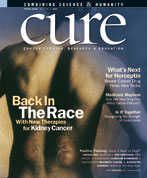Publication
Article
CURE
In the Beginning
Author(s):
Dennis Slamon, MD, PhD, discusses HER2 and the development of Herceptin.
An unconventional cancer researcher in the mid-1980s, Dennis Slamon, MD, PhD, spearheaded the discovery of the importance of HER2 and the subsequent development of Herceptin.
Twenty years ago, we were still using traditional approaches to treating cancer, using various chemotherapies and radiation, hoping to kill more bad cells than good cells. Some patients did very well, but many did very poorly, especially those with metastatic cancer.
Our group at UCLA decided to back up and study what converts a normal cell to a malignant cell and see if we could treat that specifically. We looked at all the major cancers, and when we got to a panel of breast cancer samples, we found that a gene called HER2, which was a growth factor receptor, was broken in about 25 percent of breast cancers.
Once we identified that 25 percent of the women with this problem had a more aggressive form of the disease, the next question for the lab became why. Is it simply a flag of aggressive tumors or is it playing a role in causing them? We engineered cells to have HER2 overexpressed and found they formed tumors more readily in mice, and the tumors were more metastatic, more aggressive—all the hallmarks of what we were seeing in the patient. Knowing abnormal HER2 was associated with a bad outcome made it a very logical target.
We told the drug company Genentech that our lab had identified a gene alteration in these aggressive breast cancers. Overall, the company wasn’t interested, but there was a core of scientists who felt it was worth pursuing. We collaborated with Genentech’s researchers, including one of the first scientists to clone the HER2 gene.
People didn’t believe it would work because antibodies were being tested in other tumors without success. I think people failed to recognize that HER2 wasn’t just a tumor marker—it was playing a role in causing the tumor to act badly, which made it different than the other markers.
The first human trials began in 1991. A fully humanized monoclonal antibody had never been tested in humans before, so we had to prove it was safe during those early trials, and we saw modest activity. We then conducted a trial comparing it with best available standard therapy and Herceptin proved superior.
The data validated the concept that if we identify what’s broken and target it specifically, therapies will be less toxic and more effective. Herceptin proves that, and now it has heralded a whole era of targeted therapies like Gleevec, Tarceva, Sutent—all the ones you’re hearing about now. It showed for the first time ever we could make a survival difference in patients who had this type of breast tumor. That’s what we always believed would happen.
By Dennis Slamon, MD, PhD, as told to Elizabeth Whittington.





